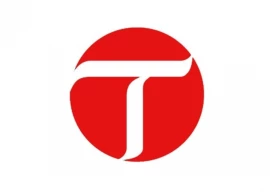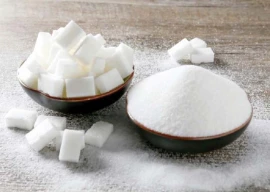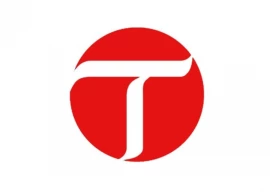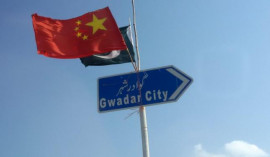
The Cabinet Committee on China-Pakistan Economic Corridor (CCoCPEC) on Thursday termed Gwadar port marketing plan prepared by Chinese operators unsatisfactory, as the government also remains unable to provide required support to make its free zone fully operational.
Due to a delay in starting work on Gwadar power plant of 300 megawatts coupled with lack of transmission network, the cabinet committee also decided to import another 100MW of electricity from Iran to meet the port’s energy requirements. The CCoCPEC meeting was held under the chairmanship of Federal Minister for Planning Asad Umar and reviewed the progress on various projects under the CPEC and Gwadar Port marketing plan, according to a press statement.
The Gwadar Port and its Free Zone is said to be the jewel of CPEC but the progress on these two major CPEC initiatives remains far below expectations despite it being a top priority of Prime Minister Imran Khan and Chief of Army Staff General Qamar Bajwa. The Chinese operators of the Gwadar port - the China Overseas Ports Holding Company Pakistan Limited (COPHC) made a presentation on the prospects of the Gwadar port and its marketing plan to the committee, sources told The Express Tribune.
However, the cabinet members raised some serious objections over the marketing plan and found it unsatisfactory, they added. A cabinet minister said that the plan lacked clarity on the strength of the Gwadar port - which is its strategic location. There was also no mention of industrial clusters that can be set up in the free zone, he added.
Two federal ministers suggested in the meeting that a way forward has to be found as everything cannot be left on Chinese operators, said the sources. However, the maritime affairs ministry officials informed that the government cannot do much as its hands were tied under the concession agreement signed with the port operators. When contacted, a senior executive of COPHC said, “Gwadar port is in operation and is capable of handling any kind of cargo.”
However, the road network is not being completed and all cargo of Gwadar has to go to the destination via Karachi, thus, reducing the competitiveness of Gwadar port, he added. The Chinese company official further maintained that the infrastructures, including power, water and road connection are the bottleneck of Gwadar port and free zone development. Land resettlement, incentive policy are preventing further development of the Gwadar Free Zone.
“However, Prime Minister (Imran Khan) visited Gwadar on July 5 and instructed the relevant authorities to remove bottlenecks of Gwadar development and the port operator is confident that with the input of all stakeholders, Gwadar can be developed as a new economic hub of Pakistan,” he added.
The Pakistan Coast Guard and Pakistan Navy still occupy nearly 97 acres of land that is part of the Gwadar Free zone, said the sources. However, the cabinet committee advised the port operators in the meeting that occupied land was only 4% of the overall zone land and the operators should expedite work to develop the rest of the area.
Electricity import
The cabinet committee also took up a summary to address the issue of less availability of the power supply to the Gwadar port and its free zone.
“The committee gave the go-ahead to the Power Division to discuss options of import of additional power supply from Iran,” according to the planning ministry.
Umar directed that dedicated power supply for the Gwadar Industrial Zone must be ensured, it added.
The Power Division had not recommended importing 100MW electricity from Iran, although the option was part of the summary that it tabled before the cabinet committee.
Under the CPEC framework agreement, Pakistan and China had planned to set up the 300MW power plant at Gwadar.
But the coal-fired power plant is expected to be commissioned by December 2023 and till that time the government does not have firm arrangement in place to meet the port city’s energy requirements.
Gwadar’s energy requirements in fiscal year 2020-21 were 199MW that are projected to increase to 236MW by 2023. The demand will further increase to 378MW by the year 2028-29, according to estimates by the Quetta Electricity Supply Company (Qesco).
In February this year, the CPEC body had directed the Power Division to present a plan for power supply to Gwadar. The existing 132KV regional grid of Makran and Gwadar is not connected with the national grid and is being fed from Iran. Pakistan is importing from 70MW to 100MW electricity from Iran since 2003.
The Power Division had recommended that in the short-term some areas of Makran grid be shifted to the national grid to meet the shortfall and also install equipment at Punjgoor to augment electricity supply. It also proposed that a new regional grid of 220KV be installed for Dadu-Makran-Gwadar transmission line that will cost $475 million.
The CCoCPEC also allowed National Transmission & Despatch Company (NTDC) to change its executing agency to expedite the work and ensure that the transmission line project for import of electricity and supplies to Gwadar is completed by March 2023. The government in 2007 had approved a project for import of additional electricity from Iran. The NTDC signed the contract with SUNIR Company in February 2009 for import of additional 100MW electricity. However, the matter could not proceed further due to international sanctions on Iran.
Tavanir and SUNIR of Iran have offered to finance the construction of line against the Tavanir payables by the power purchaser.
Published in The Express Tribune, August 13th, 2021.
Like Business on Facebook, follow @TribuneBiz on Twitter to stay informed and join in the conversation.





















COMMENTS
Comments are moderated and generally will be posted if they are on-topic and not abusive.
For more information, please see our Comments FAQ